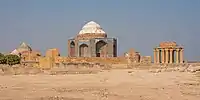Tarkhan dynasty ترخان گهراڻو | |||||||||
|---|---|---|---|---|---|---|---|---|---|
| 1554–1591 | |||||||||
.jpg.webp) Coinage of the Tarkhans, from the time of Mirza Muhammad Baqi (1567-1585). Thatta mint. Dated AH 985 (1577-8).
| |||||||||
| Common languages | Persian Arabic Sindhi | ||||||||
| Government | Monarchy | ||||||||
| Mirza | |||||||||
• 1554–1567 | Mirza Muhammad 'Isa Tarkhan (first) | ||||||||
• 1567–1585 | Mirza Muhammad Baqi Tarkhan (last) | ||||||||
| History | |||||||||
• Tarkhan dynasty begins | 1554 | ||||||||
• Tarkhan dynasty ends | 1591 | ||||||||
| |||||||||
The Tarkhan dynasty (Sindhi: ترخان گهراڻو), was established by a Tarkhan and ruled Sindh, Pakistan from 1554 to 1591 AD.[1] General Mirza Isa Beg founded the Tarkhan dynasty in Sindh after the death of Shah Husayn Arghun of the Arghun dynasty.[2]
The Mughal emperor Akbar annexed Sindh in 1591 after defeating the last Tarkhan ruler, who continued to rule as Governors for the Mughals.[3][2]
Legacy
The Arghun rulers have their tombs at the Makli Necropolis.
 "Likeness of Mirza Ghazi, son of Mirza Jani". Made by Manohar, a Mughal painter at the Tarkhan Court in the province of Thatta, circa 1610.[4]
"Likeness of Mirza Ghazi, son of Mirza Jani". Made by Manohar, a Mughal painter at the Tarkhan Court in the province of Thatta, circa 1610.[4] Tomb of Mirza Muhammad Baqi Tarkhan (1567–1585 AD), Makli Necropolis.[5]
Tomb of Mirza Muhammad Baqi Tarkhan (1567–1585 AD), Makli Necropolis.[5] Tombs of Mirza Jani Tarkhan (1585–1599 AD) and Mirza Ghazi Beg Tarkhan (1599–1612 AD).[5]
Tombs of Mirza Jani Tarkhan (1585–1599 AD) and Mirza Ghazi Beg Tarkhan (1599–1612 AD).[5]
Mirzas of Tarkhan dynasty
| Title | Personal Name | Reign |
|---|---|---|
| After civil war in Sindh between the King Shah Husayn Arghun and his nobles under Mirza Muhammad 'Isa Tarkhan the Tarkhan dynasty was victorious and began to rule over Sindh. | ||
| Mirza میرزا |
Muhammad 'Isa Tarkhan محمد عیسیٰ ترخان |
1554–1567 AD |
| Mirza میرزا |
Muhammad Baqi Tarkhan محمد بقی ترخان |
1567–1585 AD |
| Mirza میرزا |
Jani Beg Tarkhan جانی بیگ ترخان |
1585–1599 AD |
| Mirza میرزا |
Ghazi Beg Tarkhan غازی بیگ ترخان |
1599–1612 AD |
| Mirza میرزا |
Abul-Qasim Sultan Tarkhan ابوالقاسم سلطان ترخان |
1612–? AD |
| Sindh was conquered by the Mughal Empire in 1591 AD. by the general Abdul-Rahim Khan better known as Khan-e-Khanan (Khan of Khans). The green rows signify Mughal Rule. | ||
External links
See also
References
- ↑ Annemarie Schimmel (1976). Pain and Grace: A Study of Two Mystical Writers of Eighteenth-Century Muslim. p. 207.
- 1 2 Shoro, Shahnaz (21 August 2017). Honour Killing in the Second Decade of the 21st Century. Cambridge Scholars Publishing. pp. 48–49. ISBN 978-1-5275-0065-5.
- ↑ Museum, Victoria and Albert. "Mirza Ghazi Manohar V&A Explore The Collections". Victoria and Albert Museum: Explore the Collections.
- ↑ Museum, Victoria and Albert. "Mirza Ghazi Manohar V&A Explore The Collections". Victoria and Albert Museum: Explore the Collections.
- 1 2 Furnival, W. J. Leadless decorative tiles, faience, and mosaic. Рипол Классик. pp. 124–125. ISBN 978-1-176-32563-0.
This article is issued from Wikipedia. The text is licensed under Creative Commons - Attribution - Sharealike. Additional terms may apply for the media files.